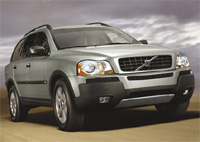Ford introduces Roll Stability Control on New Vehicles
By
Michelle M. Czarka
Vehicle
safety is the #1 concern consumers cite when researching
or purchasing a new vehicle. The automotive industry is
constantly at work engineering innovative systems to improve
vehicle safety and handling, decrease the number of automobile
accidents and provide a travel environment that cushions
you and your family.
Recently
Ford Motor Company, in keeping with its 100-year tradition
of providing customers with vehicles suited to their lifestyle
and safety demands, introduced its exclusive enhanced stability
system. Roll Stability Control™ features roll-rate
sensing and stability enhancement capabilities and works
to assist drivers in maintaining vehicle control during
extreme steering maneuvers. The system automatically engages
counter measures to help drivers maintain maximum control
of the vehicle and reduce the risk of rollover.
A
team led by Todd Brown of Ford Global Core Engineering,
Brakes and Chassis Controls Department, developed the RSC
system to reduce the occurrence of rollover accidents. The
technology grew out of the team's experience designing the
AdvanceTrac® yaw control system introduced on the 2000
Lincoln LS and Jaguar S-type.
 |
|
Volvo
XC90 is one of vehicles to be equipped with RSC. |
Ford
plans to equip more than ½ a million 2005 Ford SUVs
with RSC including their best selling Ford Explorer, Ford
Expedition, Lincoln Navigator, Lincoln Aviator, Mercury
Mountaineer and Volvo XC90. The company will also offer
this technology on its 2006 Econoline 15-passenger van.
Roll Stability Control™ will be packaged with AdvanceTrac®
chassis system which offers superior vehicle control through
anti-lock brakes, traction control and electronic stability
control.
Typical
electronic stability control systems are designed to control
yaw or skidding only but by coupling the RSC and AdvanceTrac®
systems Ford is able to provide even greater safety benefits
for the customer.
"Ford
is bringing to market tomorrow's safety technology today,"
Brown explains. "We're very pleased to offer our customers
the benefits of this new RSC technology, but Ford won't
stop here. Where customer safety is concerned, our commitment
is to continuously develop and implement innovative solutions."
In Ford's RSC system, a gyroscopic sensor determines the vehicle's body roll angle and roll rate. Along with Ford developed algorithms embedded in advanced software, this information is used with other vehicle sensors' inertial information including yaw rate, and lateral and longitudinal accelerations to monitor the vehicle's roll stability condition approximately 150 times per second. If the vehicle approaches an unstable situation, the vehicle's RSC system is activated: engine power is reduced and/or the brakes are applied to one or more of the wheels as necessary to help regain vehicle stability.
Ford has a significant number of issued and pending patents on the RSC technology and because of the immediate safety benefits RSC provides, Ford is already making it available to other companies and automakers via licenses.
Roll Stability Control™ and AdvanceTrac® are just two of the cutting-edge technologies developed and currently at work in Ford Motor Company products. Additional products available on the Ford line of vehicles are:
BeltMinder: A technology that sounds an alarm and flashes a seatbelt icon reminding drivers and passengers to buckle up. If the seatbelts remain unbuckled, the system will continue to chime and flash the warming lamp for 6 seconds every 30 seconds for five minutes or until the seatbelts are secured, whichever comes first. Research conducted by the Insurance Institute for Highway Safety during 2001 showed that safety belt usage was up 5 percent in vehicles equipped with BeltMinder.
Child Passenger Safety: In 1957, Ford became the first automaker to market child restraints and they have since continued to make huge advancements in the safety and protection of your littlest family members. In 1999, Ford was the first domestic automaker to manufacture Lower Anchors and Tethers for Children (LATCH) into their vehicles. LATCH ensures that child car seats are not only installed easier but also secured tighter providing the safest travel conditions for your child.
Air Bags: In 1966, Ford became the first automaker to enter into a joint venture with an air bag developer. Five years later, the first experimental air bag fleet was on the road. Since then, Ford has been a pioneer in air bag development and implementation being the first to offer driver-side air bags in 1985 and then dual air bags in 1989. In 1996, Ford was the first automaker to offer switches to deactivate front passenger airbags. By 1998, Ford was the first to offer side air bags on several of its models and today nearly all Ford models offer this.
Safety Canopy: Ford was the first company to feature rollover sensors and curtain rollover air bags. The Safety Canopy, first introduced on the 2002 Ford Explorer and Mercury Mountaineer, is designed to help reduce the risk of ejection in the event of a rollover. It also provides enhanced head protection in side impact collisions and rollover. Ford's rollover curtain air bags cover approximately 65 percent of the window surface area in the first two rows.
Personal Safety System: This feature incorporates more than a dozen technologies in one safety package. The system is designed to provide increased protection in many types of frontal crashes by analyzing crash factors and determining the proper response in milliseconds. The system uses dual-stage driver and front-passenger air bags capable of deploying at full or partial power. In less severe frontal crashes, air bags inflate with reduced force – or not at all – helping reduce the risk of injury due to the inflation of the air bag. The system’s pretensioners tighten the front safety belts in the first moments of a crash, and energy management retractors gradually slacken the safety belt, if necessary, to help reduce the force of the belt on the occupant’s chest. |